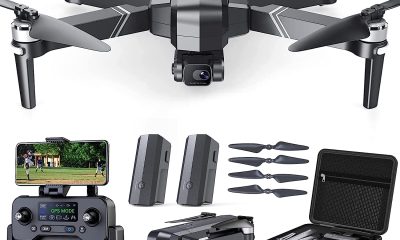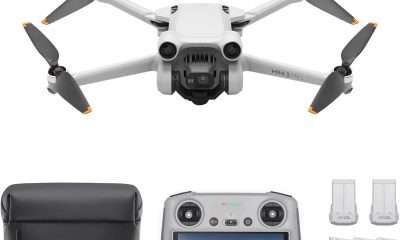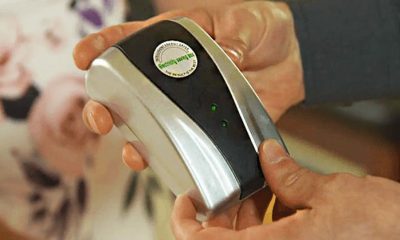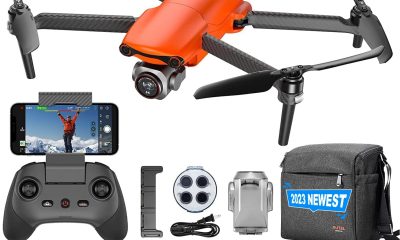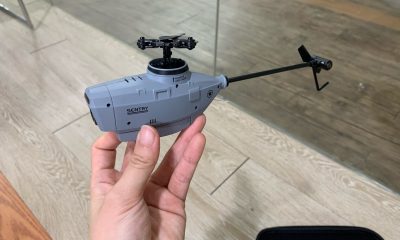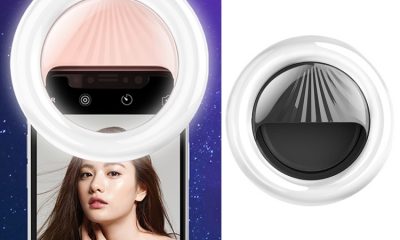Health
The Evolution of Wearable Health Monitors: From Fitness Trackers to Advanced Healthcare Tools

The world of technology has undergone a remarkable transformation, evolving from simple fitness trackers to sophisticated health monitoring gadgets that offer real-time data and insights into various aspects of our overall well-being. Initially, popular brands like Fitbit, Garmin, and Apple Watch focused primarily on tracking physical activities such as steps taken, calories burned, and heart rate. However, the landscape of health monitors has expanded significantly, incorporating advanced features that go beyond fitness tracking. Today, these devices play a crucial role in managing health conditions, identifying early signs of illnesses, and contributing to medical research.
The Progression of Wearable Health Monitors
The concept of using technology for health monitoring is not entirely new. Early versions of these gadgets were relatively basic, offering functions like step counting and heart rate tracking. With advancements in sensor technology, data analysis capabilities, and artificial intelligence integration, wearable health monitors have evolved into highly sophisticated tools. Modern devices can now monitor a range of indicators, including blood oxygen levels, electrocardiograms (ECG), sleep patterns, and stress levels. This enhanced data collection not only provides precise readings but also offers a comprehensive overview of an individual’s health trends over time.
For instance, contemporary wearable devices can continuously monitor blood pressure, alerting users to potential issues before they escalate. The Apple Watch, for example, features ECG capabilities that can detect atrial fibrillation—a condition that could lead to strokes if left unmanaged. Such functions highlight the value of wearables in both healthcare and ongoing health maintenance.
Managing Diseases with Wearable Technology
Wearable gadgets represent a breakthrough in disease management. Conditions like diabetes, hypertension, and heart disease require constant monitoring to ensure effective management. Wearable devices have simplified this process for patients, reducing the need for frequent doctor visits and enabling more personalized treatment strategies.
Take glucose monitors, for example. These devices are revolutionizing diabetes management by allowing patients to continuously track their blood sugar levels. This real-time information helps users adjust their insulin dosages, preventing dangerous spikes or drops in blood sugar and thereby reducing the risk of severe complications, such as diabetic coma or long-term organ damage.
Similarly, wearable devices designed for heart health monitoring can detect abnormal heart rhythms that may signal a potential heart attack or stroke. By alerting both the individual and their healthcare provider, these gadgets can help prevent serious health incidents before they occur.
Early Detection of Health Conditions
Wearable health trackers are also playing a significant role in early disease detection. By collecting data on various health parameters, these devices can identify trends that may indicate the onset of a disease. Some wearables, for example, are equipped with sensors that detect changes in skin temperature, which could signal an infection.
Moreover, wearables are increasingly used to monitor overall well-being. Devices that track sleep patterns, heart rate variability, and stress levels can provide insights into an individual’s mental health. For instance, recurring patterns of poor sleep and heightened stress might suggest the early stages of depression or anxiety. By recognizing these signs, wearables can prompt users to seek help before their condition worsens.
Contribution to Healthcare Research
In addition to their health management benefits, wearable health trackers are making significant contributions to medical research. The data collected by these devices offers researchers a wealth of information for studying health conditions on a larger scale. During the COVID-19 pandemic, for example, wearables were used to monitor symptoms and track the virus’s spread. The extensive data sets provided by these devices enabled researchers to identify trends and correlations that would have been challenging to uncover through traditional research methods.
Furthermore, wearable health trackers can help researchers recognize patterns in health related to lifestyle factors such as diet, exercise, and sleep. This information can be used to develop public health campaigns aimed at improving overall health outcomes.
Challenges and Future Directions
Despite their numerous advantages, wearable health trackers face several challenges. One major concern is data privacy. With a vast amount of health information being collected and transmitted, there is a risk of data breaches or misuse. Ensuring that wearable devices adhere to strict data privacy standards is essential for maintaining user trust.
Another challenge is the accuracy and reliability of the data collected. While wearable technology has made significant strides, it still lags behind clinical-grade equipment in terms of precision. False alarms or inaccurate readings can lead to unnecessary stress or incorrect medical decisions. Therefore, advancing sensor technology and data analytics is crucial for the future of health monitors.
Looking ahead, the seamless integration of health monitors with telemedicine and electronic health records is expected to become more prevalent. This integration will allow for a more holistic approach to healthcare, utilizing data from wearables to shape treatment plans and track progress over time. Additionally, advancements in artificial intelligence and machine learning will enable more personalized health insights and recommendations based on the data collected.
In summary, wearable health monitors have evolved from simple fitness trackers to powerful tools for health management and disease prevention. Their roles in managing illnesses, detecting health issues early, and contributing to medical research highlight their potential to revolutionize healthcare. As technology continues to advance, these devices are likely to play an increasingly important role in improving individual health and well-being. However, addressing challenges related to data privacy and accuracy remains crucial for fully realizing the benefits of these innovative health monitors.
Health
Fitness Gaming: Enjoyable Exertion and Exercise with Technology

In this rapid evolution of fitness, technology has become absolutely indispensable. Probably the coolest technology to arise from this is fitness gaming. The concept of fitness gaming, otherwise called “exergaming,” is to deal with fun and interactive methods of staying fit and active by taking engaging video game-playing experiences and making the activity in itself some form of physical movement.
Whether a gamer at heart or someone merely looking for ways to make exercise a more fun activity, fitness gaming is a new way to achieve health and well-being.
What is Fitness Gaming?
Fitness gaming is a form of gaming using video games that require activity to play them and include, but are not limited to, motion sensors, virtual reality, and wearables. Running parallel to the successes of “Wii Fit” and “Just Dance” has been the stellar growth of virtual reality platforms like Oculus Quest, PlayStation VR, and specialized workout apps designed to integrate with either video game platforms or mobile phones.
Apart from the normal exercises, which may be mundane and hence uninteresting, it is fun because the fitness games help gamers achieve their fitness goals.
How Fitness Gaming Works
Fitness gaming could involve several sorts of motion-tracking technologies that may be combined to provide real-time feedback. It involves motion sensing via something like XBOX Kinect or Joy-Con controllers of the Nintendo Switch that lets users both move in reaction to what is happening on screen. Virtual Reality-based games throw the user into a virtual world; one dodges obstacles, punches, or choreographs some dance while immersed in some entertaining storyline.
Most of these games are oriented toward improvement in various parts of physical health, including cardio, strength, flexibility, and coordination. A very good example involves rhythm-based games, such as “Beat Saber,” where users have to make fast hand movements through target slashes, thus fully working the arms, core, and legs. Similarly, boxing games like “Thrill of the Fight” give extremely excessive cardio sessions while teaching reflexes and hand-to-eye coordination.
Fitness Gaming: Shaping the Future
- Motivation through Gaming: Fitness gaming is hugely motivational—in fact, one of the key benefits—to a player. In cases where exercises are transformed into some sort of game, it helps keep him or her both involved and challenged. Competition, scoring, progress tracking allow the player to stay motivated toward their goals without the tensions of going to the gym.
- Accessible to All Fitness Levels: Fitness games really can work for anyone, from the total beginner up to the well-seasoned athlete. Most of these games have different difficulty levels; therefore, the player can easily adjust the difficulty, intensity, and length or duration of a workout according to one’s level of fitness.
- Full-body workout: Most of the fit games incorporate a range of motion that includes large muscle groups. Games involving jumping, squatting, stretching, and running raise a workout for the whole body to effect cardiovascular benefits, building muscle strength, and coordination. In this way, one gets to have a very good sweat without having a feeling that he/she is really doing a “workout”.
- Social Advantage: Another major plus could be a social advantage. Most of these fitness games boast multi-player functions, whereby friends or family members can work out with one another—even in the case of long-distance separations. These virtual leaderboards, online challenges, and co-op mode create a community atmosphere wherein people support and challenge each other in fun ways.
Fitness Gaming: The Future of Workouts
Technology will continue improving, and it is just about time for fitness gaming to go mainstream. Innovations in wearables, motion sensors, and even head-worn virtual reality gadgets will ensure fitness games become more immersive and physically challenging. From interactive workout apps that can measure heart rates to games that can emulate natural sports, the experiences will appeal to different kinds of people.
Fitness gaming lets many people who can’t find the time or motivation otherwise make physical exercise a form of fun and competition. Because it marries two largely separate worlds—the excitement of gaming and the health benefit of exercise—it opens the door to a very accessible, enjoyable, and sustainable form of fitness. Exergaming literally is a game-changer in the world of fitness.
Health
Telemedicine Gadgets Depict the Future of Remote Health Care

What used to be an ancillary service suddenly became mainstream in healthcare, especially after the COVID-19 outbreak. Patients and care providers found safer and more convenient means of substituting for personal visits. Telemedicine literally became the best option. Not only are more people warming up to the idea of remote health, but innovative telemedicine-related gadgets are redefining what medical care from home will look and feel like in the near future.
The Emergence of Telemedicine Devices
With increased demand for remote healthcare, specially adapted telemedicine devices will change the way patients communicate with practitioners. The ability of such tools to bridge the gap between virtual and in-person consultations rests in their promotion of better data collection and accuracy in diagnoses.
Wearable health monitors are no longer just about counting steps and detecting heart rates but have also taken the form of smartwatches and fitness trackers. Many come armed with sensors to measure blood oxygen saturation, irregular heartbeat, or even sleep patterns. This enables physicians to make real-time inferences about their patients’ health states and makes it easy to manage chronic diseases such as diabetes, hypertension, and heart disease remotely.
Best Telemedicine Devices
- Remote Monitoring Devices: Blood pressure monitors, glucometers, and pulse oximeters have become staples in remote healthcare. Patients can use these devices to check their vital statistics from home, with the data being sent instantly to their healthcare provider. A real-time dashboard can alert a doctor if the reading of a patient is outside the normal range, ensuring prompt treatment.
- Smart Stethoscopes: These are set to be a game-changer for remote consultations. Smart stethoscopes can digitize heart and lung sounds, allowing physicians to check heartbeats, breathing patterns, and other critical sounds through virtual consultations. Devices like Eko Core demonstrate how precise diagnostic tools can be integrated into telehealth for accurate at-home assessments.
- Telemedicine Kiosks: Though not home devices, telemedicine kiosks are emerging in pharmacies and clinics. Equipped with everything from thermometers to blood pressure cuffs and other critical medical devices, patients can now conduct tests on their own while being remotely guided by a healthcare provider. This reduces wait times and eliminates unnecessary hospital visits.
- Portable Ultrasound Devices: Portable ultrasound devices, such as Butterfly iQ, have allowed healthcare providers to study ultrasounds remotely. These devices help diagnose and monitor conditions related to pregnancy, organs, and more. Portable ultrasound machines are especially valuable in underserved or geographically remote communities, bridging gaps in healthcare.
Artificial intelligence (AI) applications are also extending to advanced gadget use, monitoring symptoms, showcasing personalized health tips, and even suggesting professional care when necessary. These applications analyze data from wearables or home monitoring devices and provide insights or recommendations based on the user’s health patterns.
The Benefits and Challenges
Telemedicine devices make healthcare more accessible, especially for people in rural areas or with mobility issues. They provide a safe and convenient way to monitor health without sacrificing quality care. These devices also help healthcare providers support more patients efficiently and reduce pressure on medical resources.
However, there are challenges to overcome: the devices need to be user-friendly, affordable, and accessible to all populations. Connectivity, data security, and accuracy assurance are additional hurdles that must be addressed as the technology gains momentum.
The Future of Telemedicine Devices
As technology improves, the capabilities of telemedicine gadgets will expand. Future advancements may include AI diagnostics, integrations into electronic health records, and virtual reality for remote physical therapy or surgical consultations. Telemedicine, once considered an adjunct to traditional care, has now become a crucial part of modern healthcare.
At the core of this transformation are telemedicine gadgets, helping both patients and providers navigate healthcare in a more timely, effective, and efficient manner. As these devices continue to evolve, they will guide healthcare into a future that is remote, smart, and accessible.
Health
Best Apps for Mental Well-being: From Meditation to Therapy

In today’s fast-paced world, many people are prioritizing mental health as a key aspect of maintaining balance and overall wellness. Thanks to advancements in technology, individuals now have access to mental health resources through a variety of apps designed to support them in managing stress, anxiety, depression, and overall mental well-being. These apps offer a range of features, from meditation techniques to virtual therapy sessions, catering to diverse needs and preferences, making mental health care more user-friendly and adaptable.
1. Calm: Meditation and Mindfulness Practices
Calm stands out as one of the most sought-after apps for meditation and mindfulness practices. It provides guided meditation sessions that address various life aspects, such as stress management, sleep improvement, focus enhancement, and personal development. The app is designed with user convenience in mind, offering exercises that can be completed in as little as three minutes, making it easy to integrate into any busy schedule. Additionally, Calm includes mindfulness activities for children, making it an excellent choice for families seeking ways to incorporate well-being practices into their everyday lives.
Top Features:
- Various meditation sessions available
- Relaxing sleep sounds and sleepcasts
- Exercise routines for movement and stretching
- SOS support sessions during high-stress moments
2. Headspace: Structured Mindfulness Practice
Headspace is popular among both beginners and experienced meditators due to its user-friendly design and diverse meditation offerings. The structured approach of the app helps users establish a consistent mindfulness practice, leading to enhanced clarity and emotional balance.
3. BetterHelp: Convenient Online Therapy
BetterHelp is an online therapy platform that connects individuals with licensed therapists through a convenient app. It allows for flexible therapy sessions where users can interact with their therapist via text chat, phone calls, or video calls. The services provided cover a spectrum of mental health concerns, such as anxiety, depression, relationships, and self-esteem.
Highlighted Features:
- Access to licensed therapists
- Multiple communication options
- Flexible scheduling
- Journal feature for tracking progress
One of the main advantages of BetterHelp is the opportunity to receive professional help from the comfort of one’s own home, making therapy more accessible to those who may struggle with attending face-to-face appointments. The app’s diverse communication tools enable users to seek support in a manner that aligns best with their needs.
4. Talkspace: Versatile Therapy Options
Talkspace is another online therapy app that connects users with therapists and offers multiple communication avenues such as text messages, video calls, and audio messages. Similar to BetterHelp, Talkspace focuses on addressing issues like depression, anxiety, substance abuse, and relationship challenges. This platform proves beneficial for individuals seeking therapy but facing constraints in terms of time or resources for in-person sessions.
Features:
- Connect with licensed therapists with specialized knowledge
- Unlimited messaging therapy available
- Therapy sessions offered through video, audio, or text
- Some users may have insurance coverage
Additionally, Talkspace provides psychiatry services for those needing mental health medications along with therapy. This makes it a comprehensive solution for both counseling and medication management.
5. Sanvello: Anxiety and Depression Relief
Sanvello aims to assist users in handling stress, anxiety, and depression by using cognitive behavioral therapy (CBT) techniques, mood tracking, and mindfulness practices. The app provides guided journeys focusing on mental health objectives like boosting confidence, reducing anxiety, or coping with stress. Users can also access community support to connect with others facing similar struggles.
Key Features:
- Guided journeys based on CBT principles
- Daily mood tracking and journaling options
- Meditation and relaxation techniques
- Peer support community for interaction
Sanvello’s evidence-based approach makes it a solid option for those looking for a scientifically proven way to enhance their mental well-being. The mood tracking feature helps users better understand their patterns and triggers.
6. Moodfit: Mental Health Fitness
Moodfit is a mental health app that equips users with tools to manage their emotions and overall well-being. The app features mood monitoring, mindfulness activities, cognitive behavioral therapy tools, and a gratitude journal. Additionally, Moodfit offers educational materials on mental health topics and personalized insights based on user information.
Notable Features:
- Personalizable mental health resources
- Tracking moods and thoughts
- Gratitude diary
- Breathing techniques
Moodfit’s range of tools makes it a versatile choice for those seeking to enhance their well-being through introspection and daily routines. The app’s capacity to customize its services according to individual requirements is a significant benefit for users aiming for a tailored mental health regimen.
Given the growing recognition of mental well-being’s significance, such applications provide essential support in dealing with stress, anxiety, depression, and overall wellness. Whether you wish to kickstart meditation practices, address sleep issues, or connect with a counselor, there’s an app designed specifically for your needs. By incorporating these resources into your routine, you can take proactive measures toward sustaining and enhancing your mental health.
Trending

 Drones1 year ago
Drones1 year agoRuko-F11GIM-Drones-Camera-Batteries

 Drones1 year ago
Drones1 year agoDJI’s tiny drone

 Home1 year ago
Home1 year agoElectroSave Review

 Drones1 year ago
Drones1 year agoAutel Robotics EVO Lite+ Review

 Bug Repellant Gadgets1 year ago
Bug Repellant Gadgets1 year agoSmosquito Review

 Photography & Videography Drones1 year ago
Photography & Videography Drones1 year agoStealth Hawk Pro Drone Review

 Beauty Gadgets1 year ago
Beauty Gadgets1 year agoBright Selfie Review

 Drones1 year ago
Drones1 year agoSwellpro-Fisherman-Fishing-Waterproof-Propellers Review









